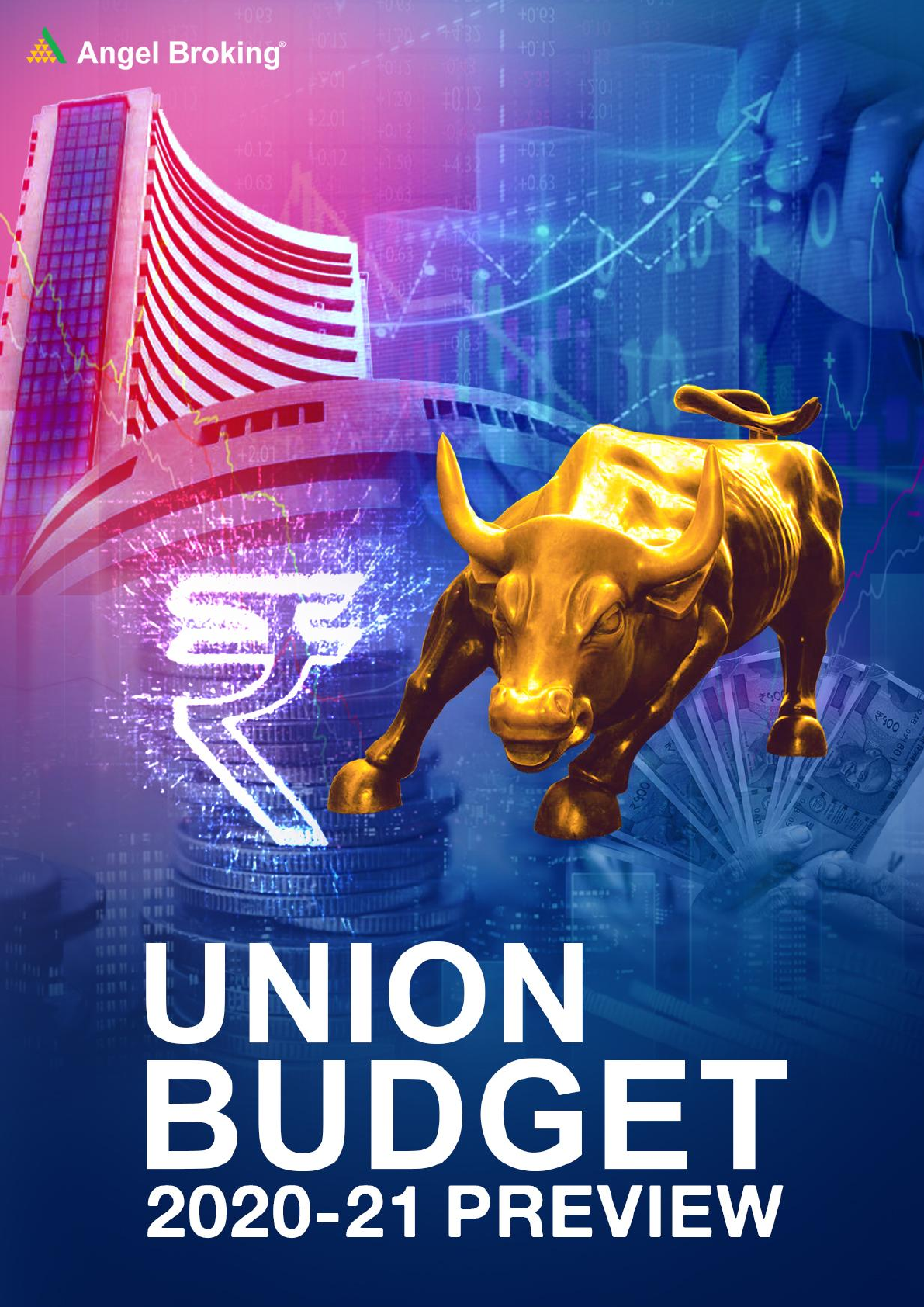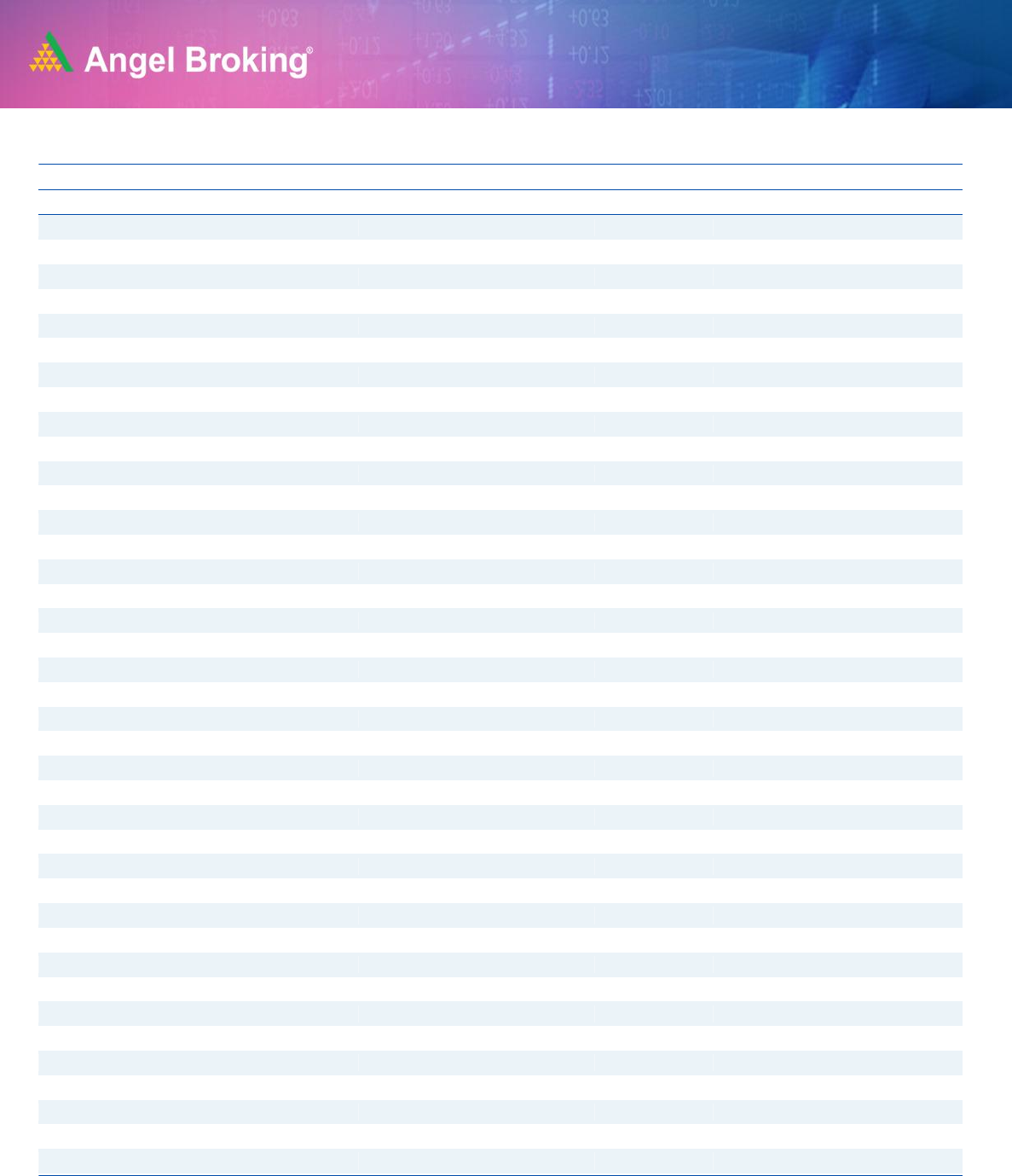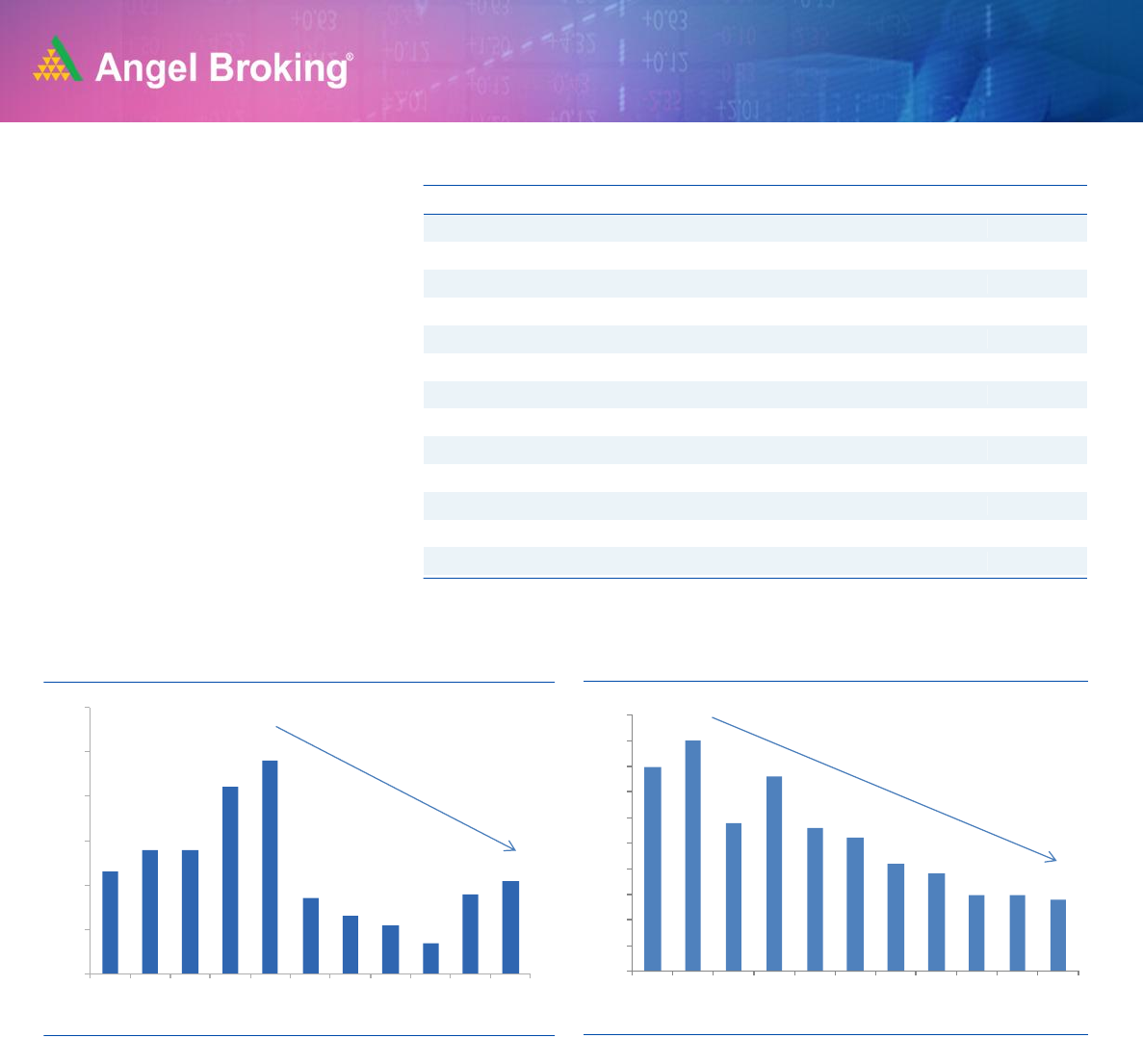
Union Budget 2020-21 Preview
1
Please refer to important disclosures at the end of this report
1
1

Union Budget 2020-21 Preview
2
Please refer to important disclosures at the end of this report
2
Bold measures need of the hour to boost growth
Given recent slowdown in the economy there are expectations that the budget
would contain bold measures to boost the economy. Tight fiscal and monetary
policy over the past few years coupled with major structural changes have taken a
toll on growth which was further exacerbated post the IL&FS crisis and its fallout.
This is reflected in the GDP numbers which slowed down to 4.5% in Q2FY20 from
8.0% in Q1FY19.
Given the shortfall in tax collections as well as lower non tax revenues (on account
of shortfall in disinvestment targets), markets are concerned about fiscal slippage
in FY20 and FY21. However in the backdrop of the current slowdown we believe
that fiscal slippage is necessary and will go a long way in boosting growth given
that India doesn't have a twin balance sheet problem like 2013.
While the corporate tax cuts was a game changer move by the Government and
would go a long way in attracting investments over the medium term we believe
that more needs to be done in order to boost consumption demand which has
slowed down sharply from 10.6% in Q4FY18 to 5.1% in Q2FY20. Given the
severity of the slowdown we feel that expansionary fiscal and monetary policy is the
need of the hour to revive the economy.
Major expectations form the Union Budget
1) Personal income tax – The Government can try and address the slump in
consumer spending by providing tax breaks to the middle class which could be
either by the way of restructuring the tax slabs or by increasing the limit of the
deductions under Sec 80 C.
2) Housing – The Government is expected to continue it’s focus on affordable
housing and we could see greater allocation under the Pradhan Mantri Aawas
Yojna along with focus on execution. The Government could also increase the
tax exemption limit on housing loan interest from current levels of ` 2 lakh.
The Government could also look at expanding the scope of affordable
housing by increasing the carpet area as well the ticket size.
3) Auto – the government is expected to announce measure to shore up the auto
industry which was impacted by the credit crisis and implementation of BS6
norms from April 2020. There is very high probability that the Government will
announce an incentive based scrappage plan in the budget which will benefit
the sector, especially the MHCV space, which has been the worst impacted.
4) Make in India – In line with the recommendations made by the commerce
ministry the Government can hike import duties on various items like paper,
footwear, rubber items and toys as well as address the issues of inverted duty
structure in certain sector like chemicals, furniture, rubber paper etc.
5) Abolition of LTCG on equities and DDT – There are expectations that the
Government may abolish LTCG on equities while definition of long term can
also be changed from one to two years. There are also expectations that the
Government might do away with the Dividend Distribution Tax DDT on equity
given that the Government want to attract investments.

Union Budget 2020-21 Preview
3
Please refer to important disclosures at the end of this report
3
FY20 Fiscal deficit and borrowing numbers expected to be on the
higher side given shortfall in tax collection numbers
The Fiscal deficit estimate at 3.4% of GDP was well ahead of glide path of 3.1%
for FY2020. While net borrowing figures are manageable at `4.73 lakh cr, gross
market borrowings are already significant at `7.61 lakh cr in FY2020 against
`5.71 lakh cr in FY2019.
Given a shortfall in revenues till date in FY20 and slowdown in the economy
revenue targets set for FY20 in the final budget is not achievable. Nominal GDP
growth has also been revised down to ~8% from earlier 11% given slowdown in
GDP growth in the first half of FY20.
Fiscal deficit till November 2019 is up by 12.7% YoY and stood at 114.8% of full
year’s budgeted estimates despite transfer of `1.48 lakh cr. of surplus from the RBI
against budgeted transfer of `90,000 cr. for FY20. There has been a significant
shortfall in tax collections till date along with lower disinvestment proceeds which is
expected to lead to a 20-30 bps slippage for FY20.
Fiscal Slippage a necessity to boost growth
Given that there is going to be revenue shortfall, it would be a challenge for the
government to meet the fiscal deficit target of 3.3% for FY20. The Government
over the past few years has generally tried to keep fiscal deficit in check by 1)
Rollover of some expenditure to the next financial year, 2) Cut back in expenditure,
3) Increase in off balance sheet expenditure with portion of subsidies being
transferred to state owned enterprise balance sheet.
In the past whenever there has been any pullback in government expenditure it has
largely been on the capital expenditure side which is not desirable given the
current slowdown in the economy. We believe that while some pullback on the
revenue expenditure the Government still has enough headroom on the fiscal side
to provide stimulus to the economy.
A 20-30bps increase in fiscal deficit for FY21 will not worry the markets much and
some amount of fiscal slippage has already been factored in by the bond markets
with the 10 year G-Sec trading at ~140bps above the repo rate as compared to
normal spread of ~75bps.
Given the severity of the slowdown we feel that expansionary fiscal and monetary
policy is the need of the hour to revive the economy before the slowdown becomes
deep rooted and well entrenched. The RBI if required could push down long term
rates by through unconventional monetary measures like Open Market Operations
(OMO) or by buying longer dated bonds while selling shorter dated ones
(Operation Twist).

Union Budget 2020-21 Preview
4
Please refer to important disclosures at the end of this report
4
Budget 2019-20 at a glance
(` in Cr)
YOY (%)
Particular (` in Cr)
FY18A
FY19RE
FY19A
FY20BE
FY19A
FY20BE
(A) Revenue Receipts (1+2)
14,35,233
17,29,882
15,63,170
19,77,693
9
27
Gross Tax Revenue (a+b)
19,19,009
22,48,175
20,78,405
25,52,131
8
23
Devolution to States/Trf to NCCD
6,73,006.0
7,61,454.0
7,61,454
8,44,605.0
13
11
%
35.1%
33.9%
36.6%
33.1%
1) Tax Revenue (Net to Centre)
12,42,488
14,84,406
13,16,951
17,05,046
6
29
a) Direct Taxes
10,01,974
12,00,000
11,25,220
13,80,000
12
23
Income Tax
4,30,772
5,29,000
4,61,650
6,20,000
7
34
Corporate Tax
5,71,202.0
6,71,000
6,63,570
7,60,000
16
15
b) Indirect taxes
9,16,972
10,48,175
9,53,185
11,72,131
4
23
Custom Duties
1,29,030
1,30,038
1,17,930
1,45,388
-9
23
Excise Duties
2,59,431
2,59,612
2,30,900
2,59,600
-11
12
Service Tax
81,228
9,283
6,880
0
-92
-100
GST
4,42,562
6,43,900
5,83,970
7,61,200
32
30
Others
4,721
5,342
13,505
5,943
186
-56
2) Non Tax Revenue
1,92,745
2,45,476
2,46,219
2,72,647
28
11
(B) Capital Receipts (3+4+5)
7,02,649
6,86,352
7,48,250
7,55,210
6
1
3) Recovery of Loans
15,633
13,155
17,840
12,508
14
-30
4) Disinvestment
1,00,045
80,000
85,045
90,000
-15
6
5) Borrowings and Other Liabilities
5,86,971
5,93,197
6,45,365
6,52,702
10
1
Total Receipt(A+B)
21,37,882
24,16,234
23,11,420
27,32,903
8
20
(C)Revenue expenditure
18,78,835
21,40,611
20,08,460
24,47,908
7
22
6) Of which interest payments
5,28,951
5,87,570.0
5,87,570
6,65,061
11
13
(D) Capital expenditure
2,63,140
3,16,624
3,02,960
3,36,292
15
11
Total Expenditure (C+D)
21,41,975
24,57,235
23,11,420
27,84,200
8
20
(E) Fiscal Deficit (C+D-A-3-4)
5,91,064
6,34,198
6,45,370
7,03,999
9
9
(F) Revenue Deficit (C-A)
4,43,602
4,10,729
4,45,290
4,70,215
0
6
(G) Primary Deficit (E -6)
5,91,064
46,628
57,800
38,938
-7
-33
GDP
1,68,87,543
1,86,52,882
1,90,10,200
2,07,05,853
13
9
Fiscal Deficit (% of GDP)
3.5%
3.4%
3.4%
3.4%

Union Budget 2020-21 Preview
5
Please refer to important disclosures at the end of this report
5
Exhibit 1: Key Financial Indicators (% of GDP)
% of GDP
FY18A
FY19RE
FY19A
FY120BE
Gross Tax Revenue
11.4%
12.0%
10.9%
12.3%
Devolution to States
4.0%
4.1%
4.0%
4.1%
Net Tax to Centre
7.4%
8.0%
6.9%
8.2%
Direct Taxes
5.9%
6.4%
5.9%
6.7%
Indirect taxes
5.4%
5.6%
5.0%
5.7%
Capital Receipt (ex borrowing)
0.7%
0.5%
0.5%
0.5%
Revenue Expenditure
11.1%
11.5%
10.6%
11.8%
Subsidies
1.3%
1.6%
1.6%
1.6%
Total Capital Expenditure
1.6%
1.7%
1.6%
1.6%
Total Expenditure
12.7%
13.2%
12.2%
13.4%
Revenue Deficit
2.6%
2.2%
2.3%
2.3%
Fiscal Deficit
3.5%
3.4%
3.4%
3.4%
Primary Deficit
0.4%
0.3%
0.3%
0.2%
Budget document, angel Research
Exhibit 2: India Current account deficit (%)
Source: Company, Angel Research
Exhibit 3: India Fiscal deficit (%)
Source: Company, Angel Research
2.3
2.8
2.8
4.2
4.8
1.7
1.3
1.1
0.7
1.8
2.1
0
1
2
3
4
5
6
FY09
FY10
FY11
FY12
FY13
FY14
FY15
FY16
FY17
FY18
FY19
6
6.5
4.9
5.8
4.8
4.6
4.1
3.9
3.5
3.5
3.4
2.0
2.5
3.0
3.5
4.0
4.5
5.0
5.5
6.0
6.5
7.0
FY09
FY10
FY11
FY12
FY13
FY14
FY15
FY16
FY17
FY18
FY19

Union Budget 2020-21 Preview
6
Please refer to important disclosures at the end of this report
6
Likely focus areas in Union Budget
Agriculture - Government expected to reiterate it’s focus on
the rural sector.
Full benefits of the “Pradhan Mantri Kisan Samman Nidhi
(PM-KISAN)” would be felt in FY21 post full rollout of the
scheme.
We also expect some further measures like tweaking of the
MSP programme.
The Government is also expected to increase outlays on the
MNREGA scheme and continue it’s focus on rural
electrification and roads.
Infrastructure – Given that Infrastructure is one of the key
focus area of the Government we don’t think that there is
going to be any cut back in capital expenditure for FY21
despite shortfall in revenues.
We believe that the Government would use the Union
Budget to highlight their plans and execution over the next
five years. Recently released National Infrastructure Pipeline
(NIP) gives us broad idea about investment by Government
in Infrastructure.
Housing - The Government could also try and stimulate
the economy by increasing the tax breaks available for
interest paid on housing loans which would lower taxable
income in the hands of the salaried class.
The Government can also look at expanding the definition
of affordable housing by increasing the ticket size and
area which will bring more projects within the ambit of
affordable housing policy.
Make in India – There are expectations that there could be
sector specific increase in import duties on specific items
while the inverted duty structure on certain sectors could
also be rationalized.
Gold – Lowering import duty on gold from current 12.5%
Impact on sectors
Positive for all Agri input related companies, as farmer
income will go up marginally.
This will be positive for the FMCG sector, as it will
increase the disposable income in the hands of rural
households. Positive for FMCG companies like HUL,
Dabur, Marico, etc.
This is likely to create a positive sentiment among first
time buyers for entry-level small cars, two wheelers and
tractors.
Positive for L&T and other Infrastructure (Road)
companies such as PNC Infratech, KNR Constructions
etc
Positive for cement companies such as Ultractech,
ACC, Shree Cement, JK Laxshmi etc.
Positive for railways allied companies like Titagarh
Wagons, Texmaco Rail etc.
Positive for Real estate companies like Sobha
Developers & Godrej Properties.
Positive for housing allied sectors like paints, plywood
tiles and cement.
Positive for sectors like footwear, chemicals &
agrochemicals
Reduction in import duty will reduce the price of gold.
This would create buying sentiment in consumer which
will be Positive for companies like Titan.

Union Budget 2020-21 Preview
7
Please refer to important disclosures at the end of this report
7
Auto - The year 2019 was one of the toughest years the
Indian automobile industry has had to undergo as a
severe slump in sales affected almost all vehicle
manufacturers. Wish list of the sector from Budget 2020
are – (a) GST reduction (on vehicles) from the existing
28% to 18% even if with a sunset clause; (b) Incentive-
based scrappage policy; (c) Abolition of duty on import of
lithium-ion battery cells; (d). Increase in re-registration
charges of vehicles to discourage use of old vehicles; (e)
Withdraw proposed hike in vehicle registration fees.
Budget Picks
GST reduction on vehicles to boost consumption on the
back of slackening demand and price hikes led by BSVI
implementation from April 2020. (Positive for all OEMs
across the segments.
The policy will make it obligatory to dispose of old
vehicles (older than a specified period of holding)
which will create demand for new (commercial)
vehicles in the market. (Positive for companies like
Ashok Leyland, Tata Motors, M&M, Automotive axle etc
in CV space.
Lithium-ion is vital to develop the EV ecosystem in
India, notably battery manufacturing. The finance
minister should also give incentives for local
manufacturing of EV batteries.
Increase in re-registration charges of vehicles to
discourage use of old vehicles will boost new demand.
Particular
CMP
Target
Price
Sales
(` Cr)
OPM
(%)
PAT
(` Cr)
ROE
(%)
P/E
(x)
EV/Sales
(x)
FY20
FY21
FY20
FY21
FY20
FY21
FY20
FY21
FY20
FY21
FY20
FY21
L&T
1,352
1,809
91,855
1,02,877
9.8
9.8
8,637
8,721
15.6
14.3
21.9
21.8
2.1
1.8
Ultratech Cement
4,643
4,984
4,3916
47,482
22.3
22.7
4,051
4,670
12.3
11.8
33.0
28.7
3.5
3.2
Ashok Leyland
86.45
95
21,193
23,376
9.6
9.9
1,103
1,228
12.6
12.8
22.9
20.6
1.0
0.9
Kajaria Ceremics
574
671
3,209
3,564
15.2
15.7
286
339
15.8
16.1
32.0
26.9
2.8
2.5
Sobha Dev.
439
500
3,786
4,152
19.9
20
313
377
13.4
14.4
13.2
11.1
-
-
Particular
CMP
Target
Price
NII
(` Cr)
PAT
(` Cr)
EPS
(`)
ROE
(%)
P/BV
(x)
FY20
FY21
FY20
FY21
FY20
FY21
FY20
FY21
FY20
FY21
Canfin Homes
471
534
601
728
367
449
28
34
19
19
2.9
2.5
CMP is Closing price as of 24
th
January 24, 2020

Union Budget 2020-21 Preview
8
Please refer to important disclosures at the end of this report
8
Research Team Tel: 022 - 39357800 E-mail: research@angelbroking.com Website: www.angelbroking.com
DISCLAIMER
Angel Broking Limited (hereinafter referred to as “Angel”) is a registered Member of National Stock Exchange of India Limited,
Bombay Stock Exchange Limited, Metropolitan Stock Exchange Limited, Multi Commodity Exchange of India Ltd and National
Commodity & Derivatives Exchange Ltd It is also registered as a Depository Participant with CDSL and Portfolio Manager and
Investment Adviser with SEBI. It also has registration with AMFI as a Mutual Fund Distributor. Angel Broking Limited is a registered
entity with SEBI for Research Analyst in terms of SEBI (Research Analyst) Regulations, 2014 vide registration number INH000000164.
Angel or its associates has not been debarred/ suspended by SEBI or any other regulatory authority for accessing /dealing in securities
Market. Angel or its associates/analyst has not received any compensation / managed or co-managed public offering of securities of
the company covered by Analyst during the past twelve months.
This document is solely for the personal information of the recipient, and must not be singularly used as the basis of any investment
decision. Nothing in this document should be construed as investment or financial advice. Each recipient of this document should
make such investigations as they deem necessary to arrive at an independent evaluation of an investment in the securities of the
companies referred to in this document (including the merits and risks involved), and should consult their own advisors to determine
the merits and risks of such an investment.
Reports based on technical and derivative analysis center on studying charts of a stock's price movement, outstanding positions and
trading volume, as opposed to focusing on a company's fundamentals and, as such, may not match with a report on a company's
fundamentals. Investors are advised to refer the Fundamental and Technical Research Reports available on our website to evaluate the
contrary view, if any
The information in this document has been printed on the basis of publicly available information, internal data and other reliable
sources believed to be true, but we do not represent that it is accurate or complete and it should not be relied on as such, as this
document is for general guidance only. Angel Broking Limited or any of its affiliates/ group companies shall not be in any way
responsible for any loss or damage that may arise to any person from any inadvertent error in the information contained in this report.
Angel Broking Limited has not independently verified all the information contained within this document. Accordingly, we cannot
testify, nor make any representation or warranty, express or implied, to the accuracy, contents or data contained within this document.
While Angel Broking Limited endeavors to update on a reasonable basis the information discussed in this material, there may be
regulatory, compliance, or other reasons that prevent us from doing so.
This document is being supplied to you solely for your information, and its contents, information or data may not be reproduced,
redistributed or passed on, directly or indirectly.
Neither Angel Broking Limited, nor its directors, employees or affiliates shall be liable for any loss or damage that may arise from or in
connection with the use of this information.

Union Budget 2020-21 Preview
9
Please refer to important disclosures at the end of this report
9
Please refer to important disclaimer at the end of this report